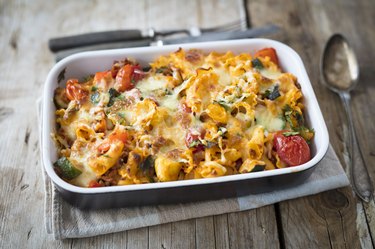
There are as many different types of casserole dishes as there are luscious, bubbly one-dish recipes to fill them with. As with most quick and economical comfort foods, there is great flexibility as far as what goes into a casserole or what kind of dish to use. But certain materials, shapes and sizes work better for one type of casserole over another. The more you know about the basics, the freer your imagination is to create your signature casserole.
Types of Casserole Dishes
Video of the Day
All casserole dishes are oven-proof, and some, such as enameled cast iron, stainless steel and lined copper, can also be used on the stove top. Some oven-proof glass casseroles can be used on the stove top, as well, but it's important to be certain about the dish you use because it will shatter if it is heated too quickly or to a temperature higher than it is designed to tolerate. Earthenware casserole dishes can be practical works of art that are as lovely on the table as they are efficient in the oven. You cannot use them on the stove top, and it's important to know where they were made, because imported earthenware casserole dishes can sometimes contain lead and should be used for display or for holding cold foods only.
Video of the Day
Choosing the Correct Size
Casserole dishes can be as small as a ramekin or nearly as large and deep as a Dutch oven. They can be any shape, including round, oval, square or rectangular. They also vary in size and depth. Choosing the right one has a definite effect on your end result. For example, putting a lasagna in a very deep dish instead of layering it in a 9-by-13-inch pan can result in an overcooked top and an undercooked middle. On the other hand, spreading a tune noodle casserole that does not contain much moisture out in a flat, shallow pan can result in a dish that's too dry.
Casserole Making Basics
The first step in any casserole is to grease the dish. You can do this with butter, with a paper towel dampened with oil, or with nonstick cooking spray. This not only makes the casserole easier to clean up afterward, it helps cut down on waste from the ingredients sticking to the dish. Use nonstick cooking spray with care; the propellant can leave an unattractive, dark residue that's almost impossible to remove. After the dish is oiled, mix together any combination of vegetables, a starch such as pasta or rice, and protein if you like, and pull it all together with seasonings and just enough sauce to keep it moist. The possible combinations are nearly endless, so don't be afraid to experiment.
Cleaning and Care
Casseroles are generally dishwasher-safe, but it may be necessary to soak a dish that has baked-on cheese that's tough to remove before washing it in the dishwasher. Let the casserole cool a bit before putting it in the sink, because even tempered glass or fired earthenware can react unpredictably to sudden temperature changes. Squirt a little bit of mild dish soap into the casserole dish and let it soak for a few minutes or overnight, depending on how stubborn the crusted-on material is. Wash the casserole with a sponge and rinse it thoroughly. While casseroles can usually go in the dishwasher, the appliance can bake nonstick spray residue onto glass, making it nearly impossible to remove without steel wool or a chemical sponge.